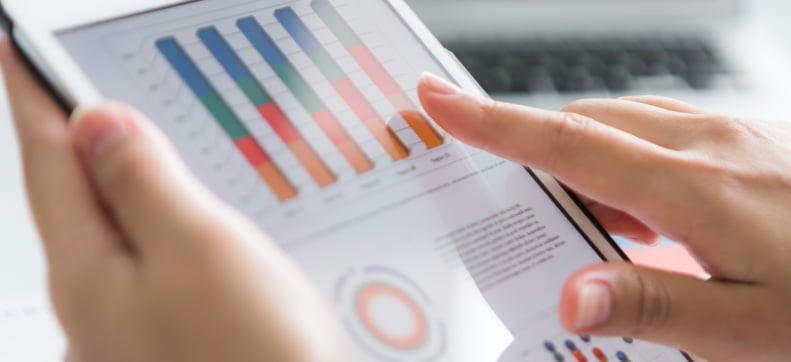
Data in retail: Transforming in-store performance
About this whitepaper
In this whitepaper, we explore how data analytics can help you improve productivity, drive up sales, and make better business decisions.
Discover:
- Why retailers struggle to get actionable insights from data
- The benefits of an insight-driven approach to in-store efficiency
- How automating insights can be a game changer for retail
Download as a PDF
Download whitepaper
Table of contents
Foreword
Brick-and-mortar grocery retailers are being squeezed from all sides. Growing e-commerce, declining customer loyalty, and the rise of discount retail are all impacting traditional retailers’ profits. There have been seismic shifts in major retail markets, too.In the UK Aldi now has a market share of 7%, overtaking Waitrose and the Co-Op. Brick-and-mortar vendors need to up their game if they are to compete in this new retail landscape.
The initial reaction to these market shifts has been to dispose of assets and reduce headcount. This is all part of the retailer’s bid to maintain margins and fund price, promotion, and multichannel investments that drive customers into physical and virtual stores. For example, retailers closed over 8,000 stores in the US in 2020. And experts predict we could see a further 10,000 closures in 2021.

Extracting value from data
Data can have a big role to play – if used correctly. Retailers have traditionally used data to generate excessive reporting, drowning their retail operations in data rather than insight. It is not unheard of for a store manager to receive over 100 reports each day and they will be expected to decipher what these reports mean and what the subsequent actions should be. They are data rich and insight poor, which impedes their ability to execute and compete.
Retailers are data rich and insight poor
The retailer’s ability to collect, store, and transmit data has grown exponentially, but their ability to manage it and create value still lags behind. Industries like manufacturing and oil and gas have actively embraced deeper analytics, artificial intelligence (AI), and the internet of things (IoT) to drive operational effectiveness. As Paul Boyle, CEO at Retail insight, asks, “retail scan data opened the door to what the world now defines as business intelligence. But has it really pushed on as far and as fast to areas such as predictive analytics?”

According to John Paul McNeil, COO at Retail Insight, “Grocery retail has traditionally focused on the creation of heavy dashboards sat on top of large data warehouses. At a time when headcount is reducing every quarter, there is not the enough resource to dig into hundreds of reports. From top floor to shop floor, our clients tell us that they want to know which actions to take to deliver highest value in the quickest time and with as little resource as possible.”
Better insights, better business decisions
But as data streams grow, could the increase in information create an endless stream of backward-looking reporting hard-pressed store managers must wade through every day? Collecting more data does not mean you are getting more insights; it merely means you are getting more data. The rear-view mirror approach to business intelligence and reporting may tell you what has happened, but you then want to know how you can do something different to make a measurable change to your performance. If you can automate this, then it is a productivity game-changer for retail.
We should focus on extracting insight through intelligent automation. Machine-driven insight that can guide, or even take action, is more valuable to retailers than basic data visualisation tools. Especially for a workforce that does not have time to look at the data, much less form it into something approaching value.
John Paul McNeil
COO, Retail Insight
Global management consultancy firm McKinsey & Company believes in the benefit of an insight-driven approach to sales and in-store efficiency. They claim that this helps retailers develop “a deeper understanding of consumer and shopper behavior and embed these insights into the way they manage every product category.” Retailers in the grocery, drug, and DIY sectors that have used the insight-driven sales approach have achieved a sales uplift of 3-5% and a net margin improvement of 1-4% in 6-18 months.
If you do not up your game when it comes to data analytics, you risk falling behind those competitors who do – and by quite a lot too. McKinsey Global Insight estimates that retailers who exploit data analytics at scale across their organizations could increase their operating margins by more than 60%.
If we can provide a positive answer when retailers ask whether this information is enabling them to do a better job in less time, or even to eliminate tasks having no value to the business, then we are on the right track to significant productivity gains.
Paul Boyle
CEO, Retail Insight
There is a large prize for automating this insight and the pressure in the market means retailers have no time to waste. Retailers that want to drive sales and productivity quickly should look to employ a trusted partner that specialize in operationalizing retail insight. This will ensure that you get the most from your data in the shortest time possible, which, in turn, allows you to concentrate on executing an optimized retail plan.
References
- https://www.kantarworldpanel.com/en/grocery-market-share/great-britain/snapshot/16.07.17/
- https://qz.com/967055/us-retailers-are-on-pace-to-close-more-stores-in-2017-than-in-the-2008-great-recession-m-bebe/
- https://qz.com/967055/us-retailers-are-on-pace-to-close-more-stores-in-2017-than-in-the-2008-great-recession-m-bebe/
- https://www.mckinsey.com/business-functions/marketing-and-sales/our-insights/how-leading-retailers-turn-insights-into-profits
- https://www.mckinsey.com/business-functions/mckinsey-digital/our-insights/big-data-the-next-frontier-for-innovation
Get in touch
Written by Paul Boyle
Paul, a Master's graduate in Engineering, became CEO of Retail Insight in 2011 having previously served as COO since the business was founded in 2005. He enjoys everything about Retail Insight; our people, products, and partners. Prior to Retail Insight, Paul worked at P&G and HJ Heinz in Commercial and Strategy.
It’s time to unleash your retail potential
You might be interested in


Latency in Data Kills On-Shelf Availability

Why FSMA 204 presents an opportunity for retailers

AI-Readiness Starts with Accurate Inventory Data

Retail Markdown Optimization: Split Packs & Damaged Items

How Dynamic Markdown Pricing Can Reduce Waste and Boost Profits

How Poor Markdown Pricing is Costing Millions

Transform stock clearance with a Stock Exit Management solution

Retail Insight continues work with Marks & Spencer to tackle food waste

BP renews with Retail Insight until 2027

Retail Insight Enhances Leadership Team with Strategic New Appointments
